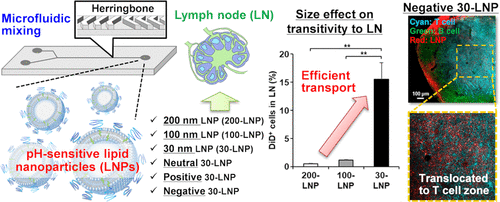当前位置:
X-MOL 学术
›
Mol. Pharmaceutics
›
论文详情
Our official English website, www.x-mol.net, welcomes your feedback! (Note: you will need to create a separate account there.)
The Effect of Size and Charge of Lipid Nanoparticles Prepared by Microfluidic Mixing on Their Lymph Node Transitivity and Distribution.
Molecular Pharmaceutics ( IF 4.9 ) Pub Date : 2020-01-28 , DOI: 10.1021/acs.molpharmaceut.9b01182 Takashi Nakamura 1 , Minori Kawai 1 , Yusuke Sato 1 , Masatoshi Maeki 2 , Manabu Tokeshi 2 , Hideyoshi Harashima 1
Molecular Pharmaceutics ( IF 4.9 ) Pub Date : 2020-01-28 , DOI: 10.1021/acs.molpharmaceut.9b01182 Takashi Nakamura 1 , Minori Kawai 1 , Yusuke Sato 1 , Masatoshi Maeki 2 , Manabu Tokeshi 2 , Hideyoshi Harashima 1
Affiliation

|
Because the lymph node (LN) is a critical organ for inducing immune responses against pathogens and cancers, the transport of immune functional molecules such as antigens and adjuvants to LNs by delivery systems is a useful strategy for the effective outcome of an immune response. The size and charge of a delivery system largely affect the transitivity to and distribution within LN. Although pH-sensitive lipid nanoparticles (LNPs) prepared by microfluidic mixing are the latest delivery system to be applied clinically, the effects of their size and charge on the transitivity to and distribution within LN are currently unknown. We investigated the size and charge effect of LNPs prepared by microfluidic mixing on transitivity to and distribution within LNs. A 30 nm-sized LNP (30-LNP) was efficiently translocated to LNs and was taken up by CD8+ dendritic cells, while the efficiency was drastically decreased in the cases of 100 and 200 nm-sized LNPs. Furthermore, a comparative study between neutral, positively, and negatively charged 30-LNP revealed that the negative 30-LNP moved to the LN more efficiently than the other LNPs. Interestingly, the negative 30-LNP reached the deep cortex, namely, the T cell zone. Our findings provide informative insights for designing LN-targeting LNPs prepared by microfluidic mixing and for the translocation of nanoparticles in LNs.
中文翻译:

微流控混合制备的脂质纳米颗粒的大小和电荷对其淋巴结传递性和分布的影响。
由于淋巴结(LN)是诱导针对病原体和癌症的免疫应答的关键器官,因此免疫功能分子(例如抗原和佐剂)通过递送系统向LN的转运是有效获得免疫应答的有用策略。交付系统的大小和费用在很大程度上影响到LN的传递性和分布。尽管通过微流体混合制备的对pH敏感的脂质纳米颗粒(LNP)是临床上最新应用的递送系统,但目前尚不清楚其大小和电荷对LN传递性和在LN中的分布的影响。我们研究了通过微流体混合制备的LNP的大小和电荷效应对LNs的传递性和分布。一个30 nm大小的LNP(30-LNP)被有效地转移到LNs,并被CD8 +树突状细胞吸收,而在100和200 nm大小的LNP的情况下,效率急剧下降。此外,在中性,带正电和带负电的30-LNP之间进行的比较研究表明,负30-LNP较其他LNP更有效地移动到LN。有趣的是,阴性的30-LNP到达了深皮层,即T细胞区。我们的发现为设计通过微流体混合制备的靶向LN的LNPs和纳米颗粒在LNs中的移位提供了有益的见识。带负电荷的30-LNP表明,负30-LNP比其他LNP更有效地移动到LN。有趣的是,阴性的30-LNP到达了深皮层,即T细胞区。我们的发现为设计通过微流体混合制备的靶向LN的LNPs和纳米颗粒在LNs中的移位提供了有益的见识。带负电荷的30-LNP表明,负30-LNP比其他LNP更有效地移动到LN。有趣的是,阴性的30-LNP到达了深皮层,即T细胞区。我们的发现为设计通过微流体混合制备的靶向LN的LNPs和纳米颗粒在LNs中的移位提供了有益的见识。
更新日期:2020-02-06
中文翻译:

微流控混合制备的脂质纳米颗粒的大小和电荷对其淋巴结传递性和分布的影响。
由于淋巴结(LN)是诱导针对病原体和癌症的免疫应答的关键器官,因此免疫功能分子(例如抗原和佐剂)通过递送系统向LN的转运是有效获得免疫应答的有用策略。交付系统的大小和费用在很大程度上影响到LN的传递性和分布。尽管通过微流体混合制备的对pH敏感的脂质纳米颗粒(LNP)是临床上最新应用的递送系统,但目前尚不清楚其大小和电荷对LN传递性和在LN中的分布的影响。我们研究了通过微流体混合制备的LNP的大小和电荷效应对LNs的传递性和分布。一个30 nm大小的LNP(30-LNP)被有效地转移到LNs,并被CD8 +树突状细胞吸收,而在100和200 nm大小的LNP的情况下,效率急剧下降。此外,在中性,带正电和带负电的30-LNP之间进行的比较研究表明,负30-LNP较其他LNP更有效地移动到LN。有趣的是,阴性的30-LNP到达了深皮层,即T细胞区。我们的发现为设计通过微流体混合制备的靶向LN的LNPs和纳米颗粒在LNs中的移位提供了有益的见识。带负电荷的30-LNP表明,负30-LNP比其他LNP更有效地移动到LN。有趣的是,阴性的30-LNP到达了深皮层,即T细胞区。我们的发现为设计通过微流体混合制备的靶向LN的LNPs和纳米颗粒在LNs中的移位提供了有益的见识。带负电荷的30-LNP表明,负30-LNP比其他LNP更有效地移动到LN。有趣的是,阴性的30-LNP到达了深皮层,即T细胞区。我们的发现为设计通过微流体混合制备的靶向LN的LNPs和纳米颗粒在LNs中的移位提供了有益的见识。



























 京公网安备 11010802027423号
京公网安备 11010802027423号